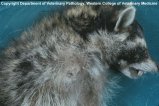| Distemper |
 |
 |
|
| |
| Causative Agent |
-
Distemper is an
infectious and
contagious
viral
disease of many domestic and wild carnivores caused by infection
with Canine Distemper Virus (CDV) of the genus
Morbillivirus.
|
| Images |
|
Click
on image to
enlarge. |
 |
|
Raccoons are often diagnosed
with distemper. |
|
| Distribution |
|
Geographic: |
-
Worldwide in distribution, but usually localized depending on the species
involved.
|
|
Seasonality: |
-
Most cases occur in spring and involve young animals not previously
exposed to the
virus.
|
|
| Hosts, Transmission and Life
Cycle |
| Hosts: |
-
Wild and domestic carnivores that can be infected with CDV include dogs
(Canidae), cats (Felidae), foxes (Vulpes),
mustelids, raccoons (Procyon),
and bears (Ursidae).
-
In North America, coyotes (Canis
latrans) and wolves (Canis
lupus) are common hosts of CDV.
|
|
Transmission: |
-
Transmission of CDV is primarily through contact with body fluids
containing the
virus or
through inhalation of fine mists
(e.g., from an infected animal coughing) containing the
virus.
-
Because CDV is so fragile in
the environment, close association between infected and
non-infected animals is necessary for transmission. As such,
dense populations of susceptible animals are necessary to
sustain an
epizootic of canine distemper.
|
|
Life Cycle: |
-
Inhaled
virus enters the upper
respiratory tract or ingested
virus enters the digestive tract
and is spread via the
lymph throughout the body,
causing damage to the
immune system.
-
Following spread to the
lymph nodes, the
virus is then often found in
parts of the digestive system and liver.
-
Widespread infection begins
about 1 week after infection and
virus may be shed in the
environment for several months after the animal recovers.
-
CDV is relatively fragile
and quickly inactivated in the environment by ultraviolet
light, heat, drying and common disinfectants.
|
|
| Signs and Symptoms |
-
Signs of canine distemper will vary depending on the species, age and
immune status of host, the strain
of
virus, and environmental
conditions.
-
Young animals are the most
susceptible.
-
The incubation period for
CDV ranges from 1 week to greater than a month, while the duration
of the disease ranges from 1 to 4-6 weeks, ending either in recovery
or death.
-
Classic signs of infection
include:
-
depression and crusting or
pus-like discharges from the
eyes and nose;
-
coughing, fever, vomiting,
diarrhea, lack of appetite and thickening of skin of the nose,
lips, eyelids, ears, anus and foot pads, particularly in
mustelids.
-
Signs of infection of the
central nervous system in several species include:
-
abnormal behavior,
convulsions, seizures,
paralysis, incoordination, aimless
wandering.
|
| Meat Edible? |
-
Meat from carnivores is rarely consumed; however, DO NOT consume meat or
feed meat to your pet from an animal that is suspected to have CDV.
|
| Human Health Concerns and
Risk Reduction |
-
CDV is not believed to be a health concern for humans.
-
Domestic dogs are a more likely source for CDV than wild carnivores.
-
To prevent spread of CDV and other diseases to domestic dogs, they should
be vaccinated and not allowed to roam free in areas where they
may encounter wild carnivores.
-
CDV has been examined as a cause of multiple sclerosis in humans. There
is at present no evidence to prove this theory.
|
| Samples for Diagnosis |
-
Submission of the whole animal is necessary as a variety of tissues must
be examined to confirm the disease.
|
| Similar Diseases |
-
Some of the
neurological signs observed in CDV infection are similar to those
seen in animals with
rabies;
however, in addition to being caused by a different
virus,
CDV infection is caused by inhaling
virus
particles, while
rabies is
transmitted through bites.
-
Because of the similarity and the potential for human infection with
rabies,
follow the protocols outlined in the description of
rabies in
this manual for how to handle an animal or carcass that is suspected
of being
rabid.
|
| Further Reading |
|
|
|
|


